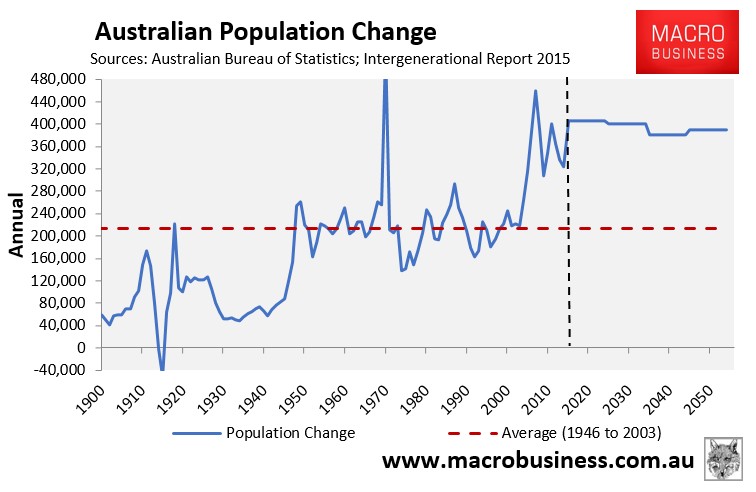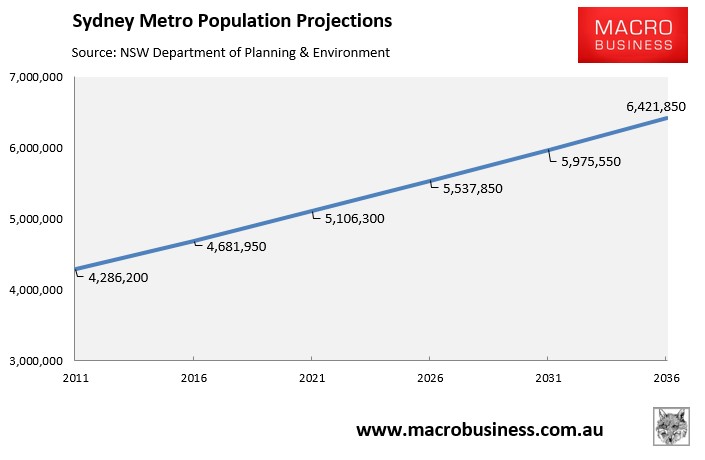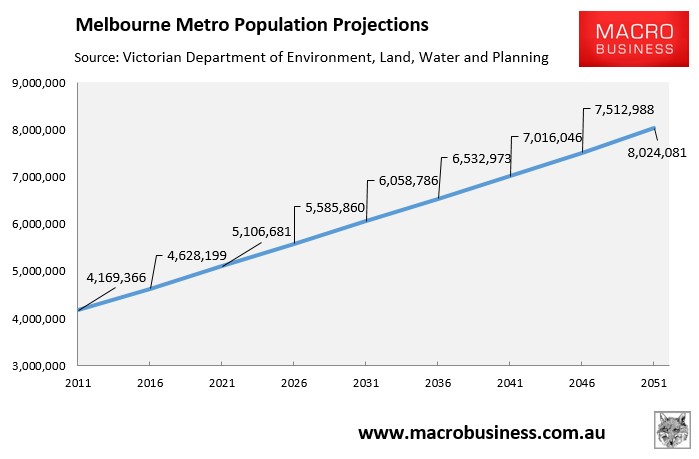Let’s recall former Treasury Secretary, Ken Henry’s, stark warning last month that Australia must undertake a massive infrastructure building program in order to avoid being choked by rapid population growth (immigration):
“The Australian population is growing by something like 400,000 a year. Think of it: a new Canberra every year between now and the end of the century. Or, put it this way, every five years building a brand new city from scratch in Australia for 2 million people.”
“Or put it this way: building a whole new city the size of Melbourne every decade between now and the end of the century”…
“My observation in Sydney and Melbourne today, is that people already think, with very good reason, that the ratio of population to infrastructure is too high. But we have set ourselves on a journey that implies an increase in that ratio. An increase in that ratio that is associated with more congestion, longer commute times to work, increasing problems with respect to housing affordability”…
Now let’s also recall Treasurer Scott Morrison’s comments last month, whereby he has refused to take advantage of record low interest rates and boost infrastructure spending because the federal budget supposedly cannot afford it. From The Australian:
The Treasurer says a further boost to infrastructure investment will have to wait until the government stops having to fund its daily spending with more debt…
Mr Morrison says there remains a role for budget investment in infrastructure projects that add to productivity and the government is funding planning and development work for projects that have “strategic merit” but are not yet ready to proceed while it has committed to funding $50bn in land transport infrastructure over the six years to 2020.
Although there is a difference between “good debt” used for infrastructure and “bad debt” used to fund recurrent spending, he says the government cannot just go out and borrow for infrastructure because interest rates are low.
“Once borrowing for recurrent expenditure is under control, we will have more headroom to take on and deploy so-called good debt,” he says.
Over the weekend, The AFR’s Jacob Greber penned a timely report on how the federal government is falling well short on infrastructure spending, which is threatening growth, jobs and living standards:
New figures obtained by the AFR Weekend indicate delays and apparent reductions in the Coalition’s $50 billion spending plan – a pledge first announced at the 2014 budget – are dragging on economic growth and contributing to an annual $18 billion of potential “missing investment”.
Analysis of unpublished Australian Bureau of Statistics data shows non-mining business investment is languishing well below its average of the past 16 years, which would be around $55.8 billion in today’s dollars.
Instead, the research shows the September quarter national accounts recorded investment outside of resources is languishing at about 32 per cent below par at $37.5 billion…
According to documents provided by the Department of Infrastructure and Regional Development to a Senate Committee, the Coalition’s first five budgets have committed to spending just $34 billion between 2014-15 and 2018-19 on new infrastructure.
The disclosure suggests the $50 billion pledge has shrunk to $42 billion at best, with around 20 per cent of that reduced amount unlikely to hit the economy for the best part of a decade.
So, the Turnbull Government supposedly cannot afford to undertake critical infrastructure investment, but somehow can still afford tens-of-billions of dollars worth of company tax cuts (see today’s other post)?
Here’s a novel idea: instead of gifting big business (and foreign shareholders) massive tax cuts, how about instead using the funds to put them to work to replenish Australia’s depleted infrastructure stock?
Because under current policy settings, the Turnbull Government will consign incumbent Australians – particularly those living in the major cities – to lower living standards.
The Coalition, just like Labor and The Greens, are a rabid supporter of mass immigration and a ‘Big Australia’. Scott Morrison himself has also acknowledged that immigrants tend to settle in inner city areas:
“When immigrants have come to major cities all around the world, they have tended to congregate around inner city areas. That has been one of the most established settlement practices for a millennia”.
Australia’s population is projected by the government to increase by some 400,000 people a year – effectively a new Canberra – for the next 40-years, meaning that Australia will need to build-out the equivalent of three new Sydney’s over that time period just to keep the stock of infrastructure per capita constant:

Most of this growth is also projected to occur in our two major cities, which are projected to grow by 1,650 people per week (Sydney) and 1,850 people per week (Melbourne) for decades to come:


Blind Freddy – but clearly not the Turnbull Government – can see that residents in these cities are facing horrid ‘crush loading’ unless there is massive infrastructure investment.
The choice is simple: if the Turnbull Government chooses to maintain a mass immigration policy, then it must fund the required infrastructure and services. This necessarily requires abandoning financial black holes like the planned company tax cut. But, if the Turnbull Government does not wish to fund massive infrastructure investment, then it must dramatically cut immigration.
However, to maintain the throttle on population growth, while at the same time refusing to undertake the necessary associated investment, is a guaranteed recipe for destroying Australian living standards and is totally unacceptable.
Australians and its media must hold the Turnbull Government to account. They should also demand that it abandons the costly company tax cut in favour of massive infrastructure investment.

